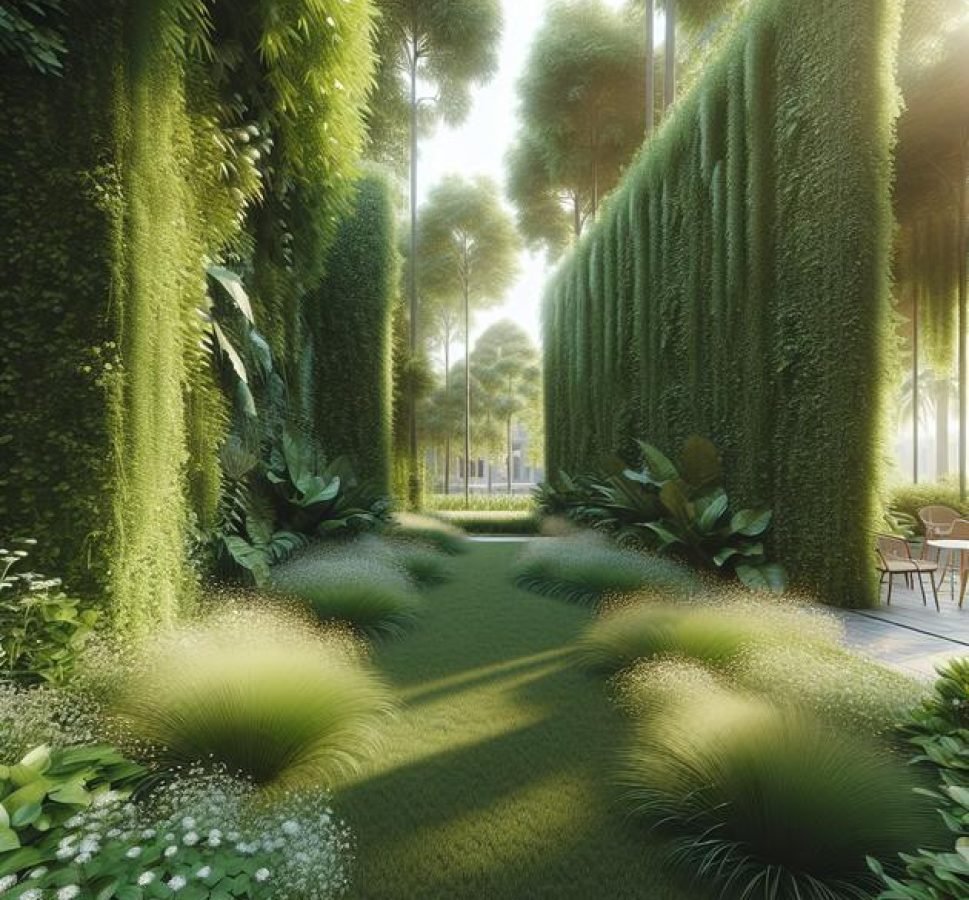Natural room dividers using plants create functional and stylish space separators that improve air quality, enhance privacy, and bring a refreshing natural aesthetic to indoor environments.
Have you ever considered how natural room dividers using plants can refresh your space? They create more than separation; they bring life and a touch of nature indoors. Curious to see how this changes your home vibe?
why choose natural room dividers
Choosing natural room dividers offers a unique way to separate spaces while bringing life and freshness into your home. Unlike traditional dividers, plant-based dividers improve air quality and add natural beauty. They create a calming environment that can reduce stress and enhance your mood. Additionally, natural dividers are versatile, fitting various interior styles from modern to rustic.
Plants also provide practical benefits such as sound absorption, helping to reduce noise between rooms. They can be customized in size, shape, and plant choice to suit any space, making them a flexible option for both large and small areas. With proper care, they last longer than many other divider materials, growing and evolving with your home’s design.
Another key reason to choose natural dividers is their eco-friendliness. Using plants supports sustainability by reducing the need for plastic or synthetic materials. Plus, they promote a connection with nature, important for indoor environments where people spend most of their time.
Benefits at a Glance
- Improves indoor air quality
- Enhances mood and well-being
- Customizable and adaptable
- Absorbs sound to reduce noise
- Eco-friendly and sustainable choice
types of plants suitable for room dividers
When selecting plants for natural room dividers, it’s important to consider factors like size, light requirements, and maintenance. Tall and bushy plants such as the fiddle leaf fig, snake plant, and bamboo palm provide excellent coverage and structure. These plants create a strong visual barrier while adding greenery that thrives indoors.
For lower dividers or partial separation, consider medium-sized options like the peace lily or rubber plant. These add lush texture without overpowering the space. Hanging plants such as pothos or string of pearls work well when suspended in planters to create vertical dividers without taking up floor space.
Succulents and cacti suit dividers in bright, dry areas but may need to be complemented with taller plants for effective separation. Also, plants like ferns and spider plants thrive in lower light and add softness to dividers.
Choosing Plants by Environment
- Low light: snake plant, ZZ plant, pothos
- Bright indirect light: fiddle leaf fig, rubber plant, peace lily
- Dry conditions: succulents, cacti
- High humidity: ferns, bamboo palm
Combining these plants strategically ensures your natural divider not only looks stunning but also stays healthy and vibrant throughout the year.
how to create a plant wall divider
Creating a plant wall divider can transform your space into a vibrant, green sanctuary. Start by choosing a sturdy frame or grid that can support the weight of your plants. Wood, metal, or repurposed pallets work well as bases. Attach pots, planters, or pockets to the frame, ensuring there is enough room for root growth and air circulation.
Next, select plants that thrive vertically and suit the lighting conditions of your area. Trailing plants like pothos, ivy, and spider plants look beautiful cascading down. Compact plants such as succulents or ferns can fill gaps. Use a combination of plants with varying textures and shades of green to create depth and interest.
Mounting and Maintenance Tips
Secure the plant wall divider in a location where it receives appropriate light, keeping accessibility in mind for watering and pruning. Consider installing a drip irrigation system or using self-watering planters to ease maintenance. Regularly trim plants to prevent overcrowding and replace any that don’t thrive.
Plant wall dividers not only offer privacy but also improve air quality and add a natural aesthetic that uplifts any room.
using hanging plants as dividers

Using hanging plants as dividers is a smart and stylish way to separate spaces without sacrificing floor area. Suspended planters or macramé hangers can be installed from ceilings, beams, or wall brackets to create natural green partitions. This approach adds visual interest and maximizes the use of vertical space.
Choose trailing plants like pothos, string of pearls, or philodendrons, which cascade beautifully and soften the boundaries between rooms. Ferns and spider plants also work well, providing lush greenery with minimal care. Hanging plants are especially great for small spaces or open layouts where a solid divider would feel too heavy.
Installation and Care Tips
Ensure your hanging setup is secure enough to hold the weight and position plants where they can receive adequate light. Use lightweight pots and consider self-watering planters to reduce maintenance. Regular trimming helps keep hanging plants healthy and encourages fuller growth, enhancing their role as natural dividers.
This method combines aesthetics with function, delivering a refreshing and airy feel while subtly marking distinct zones within a room.
benefits of living room dividers
Living room dividers offer more than just physical separation; they can transform the entire feel and function of a space. One major benefit is creating distinct zones within open floor plans, allowing activities like relaxing, dining, or working without distractions. This adds privacy and helps organize your living space efficiently.
Natural dividers like plants also enhance indoor air quality by filtering pollutants, which contributes to a healthier environment. They bring calming greenery that reduces stress and improves mood, making your living room more inviting and comfortable.
Another advantage is the aesthetic boost. Dividers add texture, color, and height variation, breaking the monotony of large rooms. A well-chosen divider can become a focal point, reflecting your personal style with elements like wood, metal, or lush greenery.
Additional Practical Benefits
- Sound reduction between zones, making the room quieter
- Flexibility to rearrange or remove dividers as needed
- Provides surfaces for decoration or storage when using shelves or panels
- Helps control light flow without fully blocking natural light
Using living room dividers effectively maximizes space usage while promoting a balanced and harmonious home atmosphere.
how to care for plant dividers
Proper care is essential to keep plant dividers healthy and vibrant. Start with selecting plants that match the light conditions in your space. Most indoor plant dividers thrive in bright, indirect light but some like snake plants or ZZ plants tolerate lower light levels.
Consistent watering is key; overwatering is a common mistake. Check soil moisture regularly and water only when the top inch feels dry. Use pots with drainage holes to prevent root rot. Employing a moisture meter can help maintain the perfect balance.
Additional Care Tips
- Fertilize plants every 4-6 weeks during the growing season using a balanced, water-soluble fertilizer.
- Prune regularly to encourage fuller growth and remove dead or yellowing leaves.
- Dust leaves gently with a damp cloth to keep pores clear and enhance photosynthesis.
- Rotate plants occasionally to ensure even light exposure on all sides.
- Watch for pests like spider mites or aphids and treat promptly with natural insecticides if needed.
By following these simple but effective care steps, your plant dividers will remain a lush and attractive feature in your home.
combining dividers with furniture
Combining dividers with furniture is a clever way to add function and style to any room. Furniture pieces like bookshelves, console tables, and benches can serve dual purposes as dividers, providing separation as well as storage, seating, or display areas. This approach maximizes space and keeps the environment open yet organized.
Open shelving units filled with plants, books, or decorative items create a natural partition that still lets light through and maintains visual flow. Low sideboards or dressers can define living and dining areas while offering storage for essentials.
Tips for Effective Integration
- Choose furniture that complements the room’s style and scale to avoid overcrowding.
- Use plant dividers on or around furniture pieces to soften edges and add greenery.
- Select modular or mobile furniture to allow easy rearranging if needed.
- Layer textures and colors between plants and furniture for a cohesive look.
This method not only defines areas but also enriches your interior decor with practical and attractive solutions.
choosing pots and containers

Choosing the right pots and containers is key to creating effective natural room dividers with plants. Consider size, material, drainage, and style to ensure plants thrive and complement your space. Larger pots are ideal for tall, bushy plants offering substantial coverage, while small pots work for delicate or hanging plants.
Materials such as terracotta allow for breathability and moisture control, while ceramic and plastic pots retain water longer, suitable for plants needing consistent hydration. Self-watering containers are great for low-maintenance dividers.
Style and Functionality Tips
- Choose colors and textures that match or contrast with your décor for visual appeal.
- Use lightweight containers for hanging dividers to ease installation.
- Group similar pots for a cohesive look or mix styles for an eclectic vibe.
- Ensure every pot has proper drainage to prevent root rot and promote healthy growth.
The right containers not only support healthy plants but also enhance the overall aesthetic of your natural room divider.
light requirements for indoor plant dividers
Understanding light requirements is crucial for maintaining healthy indoor plant dividers. Most indoor plants prefer bright, indirect light, which mimics their natural environment under tree canopies. Positioning your plant divider near a window with filtered sunlight ensures they get enough light without being scorched.
Some plants tolerate low light conditions and are perfect for dimmer corners. Examples include snake plants, pothos, and ZZ plants. These require less sunlight but still contribute to a lush room divider. On the other hand, sun-loving plants like succulents and fiddle leaf figs need more direct or bright light to thrive.
Tips for Managing Light
- Rotate plants regularly to promote even growth and prevent leaning toward light sources.
- Use grow lights if natural light is insufficient, especially during shorter winter days.
- Observe your plants for signs of too much light, such as scorched leaves, or too little light, like slow growth and pale leaves.
Properly matching plants to your room’s light conditions is key to a vibrant and lasting natural room divider.
best plants for low-maintenance dividers
For low-maintenance natural room dividers, choose plants that thrive with minimal care. Snake plants, ZZ plants, and pothos are excellent options as they tolerate low light and irregular watering. These resilient species remain vibrant without demanding much attention.
Succulents and cacti are also ideal for low-maintenance dividers, especially in bright areas. They require little water and adapt well to various indoor conditions. Their unique textures add a modern touch to your space.
Other Easy-Care Plants
- Spider plants – grow quickly and purify air.
- Peace lilies – beautiful blooms and tolerate shade.
- Cast iron plants – virtually indestructible and ideal for shady spots.
These plants give your divider a lush, healthy look without demanding time-consuming care, making them perfect for busy lifestyles.
using bamboo and reeds as dividers
Bamboo and reeds are excellent natural materials to use as room dividers, offering a lightweight, eco-friendly, and stylish alternative. Bamboo’s tall, slender stalks create a semi-transparent partition that allows light to filter through while providing privacy. Reeds add texture and an organic feel, making spaces appear cozy and inviting.
Both materials are durable and easy to install, working well in indoor spaces with moderate to bright indirect light. Bamboo poles can be arranged vertically in a frame or used as standalone screens, while bundled reeds offer a softer, woven look that complements various décor styles.
Care and Practical Tips
- Place bamboo and reeds away from direct sunlight and excessive moisture to prevent cracking or mold.
- Clean regularly using a dry cloth or gentle vacuuming to remove dust.
- Consider treating bamboo with a natural sealant to extend its lifespan.
- Combine these dividers with indoor plants for a lush, tropical vibe.
Using bamboo and reeds as dividers brings natural elegance and a sense of tranquility to your living spaces.
creative planter arrangements

Creative planter arrangements can turn natural room dividers into stunning focal points. Mixing pots of varied sizes, shapes, and heights adds depth and visual interest. Layering trailing plants alongside upright species creates texture and flow.
Use plant stands or shelves to create vertical height differences, allowing smaller plants to peek through and larger ones to stand tall. Incorporating colorful pots or unique containers like baskets, ceramic bowls, or vintage crates gives personality to your setup.
Tips for Stunning Arrangements
- Group plants with similar care needs together for easier maintenance.
- Combine varying leaf shapes and colors for contrast and balance.
- Use empty spaces creatively – add stones, driftwood, or decorative moss.
- Rotate plants regularly to ensure even growth and exposure.
Overall, thoughtful planter arrangements enhance the beauty and functionality of your natural room dividers.
space-saving ideas with plant dividers
Maximizing space with plant dividers is perfect for small homes or apartments. Vertical gardens mounted on walls or freestanding plant ladders take up minimal floor space while providing lush greenery and room separation. Hanging plants also free floor space and add a light, airy feel.
Using slim, tall planters instead of wide pots allows for efficient use of narrow spaces like hallways or corners. Modular plant stands can be stacked or arranged as needed, offering flexibility.
Additional Space-Saving Tips
- Choose plants that grow upwards or cascade rather than spread wide.
- Combine storage and greenery by using planters with shelves underneath.
- Place plants on room dividers that double as shelving units for books or decor.
- Use lightweight materials to easily move dividers and adjust layouts.
These space-saving ideas ensure your natural room dividers are functional without cluttering your living area.
seasonal changes and plant dividers
Seasonal changes affect the health and appearance of plant dividers, so adapting care is important. In spring and summer, most plants enter a growth phase, needing more water, fertilizer, and sunlight. Regular pruning during this time encourages fullness and removes any damaged leaves.
During fall and winter, many plants enter dormancy, requiring less water and nutrients. It’s key to reduce watering to prevent root rot and move dividers away from cold drafts or heating vents that dry the air.
Managing Seasonal Care
- Adjust watering schedules based on temperature and humidity.
- Provide supplemental light in darker months with grow lamps to maintain plant health.
- Inspect frequently for pests that may become more active indoors during colder seasons.
- Repot or refresh soil in early spring to prepare for the growing season.
By responding to seasonal shifts, your natural room dividers will stay vibrant and continue enhancing your space year-round.
tips for styling your natural divider
Styling your natural room divider enhances both its function and appearance. Start by mixing plant sizes and shapes to create a dynamic look. Tall plants provide structure, while smaller, trailing varieties add softness and movement.
Incorporate decorative pots and planters that complement your room’s color palette and style. Using materials like ceramic, terracotta, or woven baskets adds texture and warmth.
Styling Tips
- Group plants with similar light and water needs for easier care.
- Add decorative elements such as fairy lights or small sculptures for personality.
- Use plant stands or shelves to add height variation and layers.
- Keep pathways clear for easy access and prevent overcrowding.
Regularly rotate plants and refresh arrangements to keep your divider looking fresh and inviting all year round.
Bringing Natural Room Dividers to Your Space
Natural room dividers using plants offer a simple and beautiful way to refresh your home. They not only separate spaces but also add life, color, and a calming vibe.
With the right plants, pots, and styling tips, you can create dividers that fit your style and needs. Caring for these plants throughout the seasons ensures they stay healthy and vibrant.
Whether you have a small apartment or a large open plan, natural dividers are flexible and eco-friendly solutions that enhance both function and beauty in your living space.





